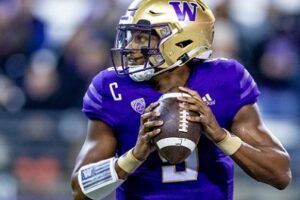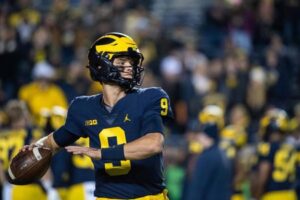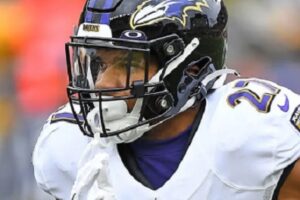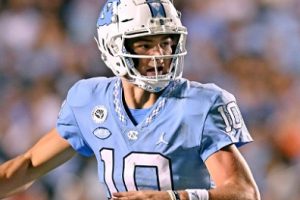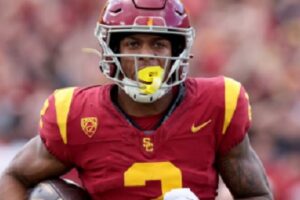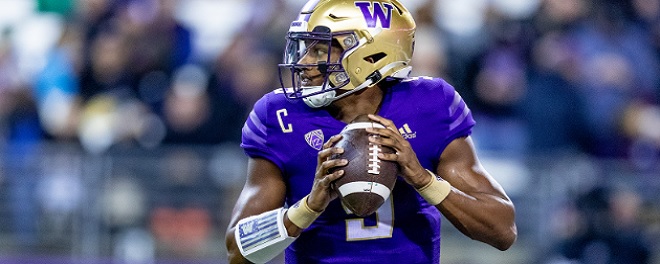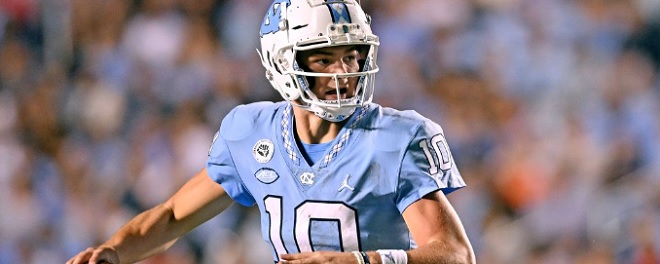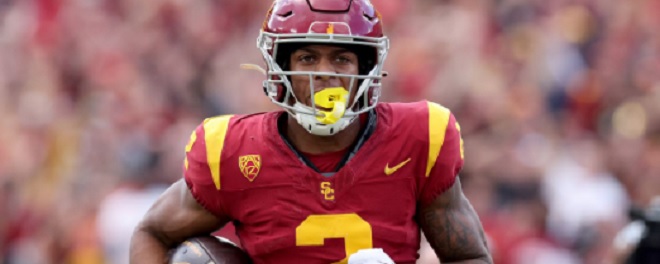By Charlie Campbell.
Send Charlie an e-mail here: [email protected]
Follow Charlie on Twitter @draftcampbell for updates.
This page was last updated March 27, 2020. Follow me @walterfootball for updates.
Safety Class
Early-round talent: C+
Mid-round: B
Late-round: C
Overall grade: C+
2020 prospects vs 2019
Darnell Savage
Johnathan Abram
Xavier McKinney
Antoine Winfield
Grant Delpit
Marquise Blair
Nassir Adderley
Kyle Dugger
Taylor Rapp
Juan Thornhill
Will Harris
Jeremy Chinn
Mike Edwards
Ashtyn Davis
J.R. Reed
Darnay Holmes
Last year had a good class of safety talent that I gave an overall grade of A-. The 2020 NFL Draft is not as strong at safety. The 2019 NFL Draft saw two safeties go in Round 1 and four more selected in Round 2. This year, there may only be one safety who gets drafted on Thursday night, plus the second-round group could fall short of last year’s total as well.
This year’s top safety is Alabama’s Xavier McKinney, and he is comparable to Darnell Savage and Johnathan Abram. McKinney is smaller, hence they are rated over him. Antoine Winfield and Grant Delpit are second-round talents who should go higher than Marquise Blair did last year. Kyle Dugger is not as good of a prospect as Nasir Adderley, but I think Dugger is better than Taylor Rapp. Juan Thornhill was a steal for Kansas City in the second round and is on his way to being a better pro than some of the safeties drafted ahead of him. Jeremy Chinn is a third-round prospect who I would put between Will Harris and Mike Edwards. I would place the trio of Ashtyn Davis, J.R. Reed, and Darnay Holmes behind Edwards.
Safest Pick: Xavier McKinney, Alabama

Previous Picks:
2019: Johnathan Abram
2018: Minkah Fitzpatrick
2017: Malik Hooker
2016: Jalen Ramsey
2015: Landon Collins
2014: HaHa Clinton-Dix
2013: Kenny Vacarro
My track record here is pretty good. Abram played well early on as a rookie before getting hurt, so obviously not enough time has gone by to render judgment. Fitzpatrick had a decent rookie year and was superb in his second season. Hooker was tremendous before his rookie seasons was robbed by an injury, and he’s been solid since then. Ramsey is a stud, albeit at corner. Collins and Clinton-Dix are both quality safeties, while Vacarro is a solid starter, but not special.
This was an easy pick with McKinney. For the next level, he has Pro Bowl potential as he is very versatile in pass coverage and is a weapon against the passing game. He can play man-to-man, free safety or strong safety and has very good instincts. In run defense, McKinney is tough and a willing tackler. If he were bigger and had run faster at the combine, McKinney would have likely been a top-20 pick based off his play and excellent college tape. As long as he can stay healthy, I think McKinney will be a good NFL safety.
Biggest Bust Potential: Ashtyn Davis, California

Previous Picks:
2019: Deionte Thompson
2018: Ronnie Harrison
2017: Jabrill Peppers
2016: Darian Thompson
2015: Gerod Holliman
2014: Ed Reynolds
2013: Eric Reid
My track record here is solid. Eric Reid is the blemish since he has turned into a quality NFL player. Reynolds, Holliman and Thompson didn’t work out. Peppers struggled as a rookie, but he played better in New York. Harrison and Thompson have yet to break out, but they still have time and one can’t judge yet on them.
Davis has received some early-round projections, but I think he has bust potential. Here’s how one source summarized him:
-
“I graded him in the fourth [round] but might move him up to the third. He’s not strong, not physical, and misses a ton of tackles. It looks like he doesn’t have the heart to tackle. On tape, some of the lack of physicality was utterly criminal. He is athletic, but doesn’t make a ton of plays in coverage and is not a rangy instinctive centerfielder. In the NFL, he going to get run over and run off the map.”
Safety Rankings by Attributes
Man Coverage:
NFL prototype: Earl Thomas, Ravens
- Xavier McKinney
- Antoine Winfield
- Kyle Dugger
- Grant Delpit
- Ashtyn Davis
- Darnay Holmes
- Jeremy Chinn
- J.R. Reed
Recap: The NFL is a passing-driven league, and safeties with the ability to play some man coverage are a hot commodity. Many safeties are too stiff to match up against a slot receiver, a tight end or a receiving running back. Offenses seek out those mismatches, so good safeties have some man-coverage ability.
McKinney has serious man-coverage skills for the NFL, and he is better in man than many other safeties who have been first-round picks in recent years. McKinney has the man-coverage skills to play cornerback against slot receivers and also play man-to-man on receiving tight ends. With his speed, athleticism and instincts, McKinney does a superb job of running with them and preventing separation.
Winfield has man-coverage potential for guarding slot receivers and wideouts downfield. He is fast and instinctive. However being 5-foot-9 is a problem for him, as he can’t do much about players making catches over him.
To go along with his excellent size and speed, Dugger has enough athleticism to play man coverage on tight ends. However short-area movement could be problematic for him, so he should not play nickel corner against slot receivers.
Delpit has the potential to play man coverage. If Delpit grows stronger, he could help cover tight ends and big receivers in man coverage because he has the speed to run with them and the size to handle height. Right now, however, tight ends could push him around, so he needs to get more physical.
Davis has the potential to play some man coverage on slot receivers because he has the speed to run with them, but he is too small to match up against tight ends or big receivers as they will push him around and make catches over him. That is the same is for Holmes.
Chinn has some significant limitations because he is very stiff and tight. That is common with large safeties, so Chinn does not project to being able to play man coverage on NFL receivers or tight ends since he will have a hard time of running with them out of breaks. They will be able to consistently create separation and get open downfield if Chinn is put in man coverage.
Reed is a good zone safety, but he doesn’t have the speed or athleticism to really play man in the NFL.
Zone Coverage:
NFL prototype: Earl Thomas, Ravens
- Xavier McKinney
- Antoine Winfield
- Kyle Dugger
- Grant Delpit
- Ashtyn Davis
- J.R. Reed
- Jeremy Chinn
- Darnay Holmes
Recap: The ability to play well in zone coverage is a must in the NFL. There are teams that weigh this heavier than others due to scheme. Zone safeties need to be intelligent and cover a lot of ground while playing disciplined and instinctive football. They have to be able to pick up receivers who work through the short and intermediate part of the field. None of these safeties looked bad in zone. In fact, all are pretty good in zone.
McKinney can play free safety in the deep part of the field, covering a lot of ground and keeping offenses from getting receivers open deep over the top. McKinney also has the ability to cover in zone in the short part of the field, something typically reserved for strong safeties. Defensive coordinators are going to love having McKinney in their secondary because he can be a problem solver.
Winfield is good at zone coverage because he has free safety potential for the NFL. He can play the deep centerfield and cover a lot of ground. With good instincts, speed, athleticism, and superb ball skills. Winfield is an asset in zone coverage.
Dugger is a play-making strong safety who is dangerous in zone coverage in the middle of the field. He can dish out some hard hits across the middle and has a knack for being around the ball, but he should not be a single high deep free safety because he is a true strong safety.
Delpit is better in zone coverage in the short to intermediate part of the field. He has the speed to cover ground there, but doesn’t have great range to be a deep centerfielder as a free safety. Occasionally at free safety, he can react a hair late to deep passes and/or take a bad angle downfield.
Davis is fast and shows range. He covers a lot of ground in the deep part of the field with the speed and athleticism to get to the sideline from the middle of the field on deep throws. However, Davis does not make a ton of plays in coverage and doesn’t seem to have the instincts to be the rangy centerfielder that he needs to be given his body type and lack of strength.
Reed is a quality zone safety who does a nice job of breaking on the ball while flashing range on the back end. He played free safety in college and could be a zone free safety in the NFL. If he were faster and more athletic, he would be rated higher.
Chinn is an enforcer in the middle of the field who will punish receivers for crossing the middle. He could contribute as a zone safety in the short to intermediate part of the field, but his change-of-direction limitations and stiffness make him not a great fit to be a deep free safety in zone coverage.
Holmes has decent instincts and is competitive, but he is short and lacks speed, so he could have problems covering ground in zone coverage as a pro. Additionally, catches being made over him when he is in position will be an issue.
Run Defense:
NFL prototype: Landon Collins, Redskins
- Kyle Dugger
- Xavier McKinney
- Jeremy Chinn
- Grant Delpit
- J.R. Reed
- Antoine Winfield
- Darnay Holmes
- Ashtyn Davis
Recap: The NFL doesn’t have as large of a need for the big, physical safeties of the ’80s and ’90s, who were mini linebackers. Still, coaches want safeties who are good tacklers and run-defenders who are capable of playing in the box. There are a number of solid run defenders in this draft class. In fact, all eight of these safeties have shown the ability to be quality run defenders.
In run defense, Dugger is a tough safety who has good size and strength. He has the ability to take on power backs and was a good tackler. Dugger’s speed comes through with him flying downhill, hybrid potential where he could be moved to linebacker in the sub package. Dugger is making a big jump in competition, so it might better for him to get comfortable one position before being moved to other spots.
Chinn is a solid contributor in the ground game. He has good size and strength to tackle NFL running backs. His instincts are okay, and his straight-line speed allows him to cover a lot of ground while being able to come down hill in a blur. As a run defender, Chinn should be a good enforcer and can function as the eighth man in the box.
In the ground game, McKinney is tough and can tackle. While he doesn’t have a lot of size or bulk to him, he is a willing tackler and not afraid of taking on backs. McKinney showed real toughness at Alabama and was a solid run defender for the Crimson Tide. It will be interesting to see if McKinney is able to avoid injury in the NFL given his size and the physicality.
Delpit contributes as a run defender. He uses his instincts to fire to the ball and make plays. In 2019, Delpit missed a lot of tackles and didn’t play with good strength, so he needs to improve that for the next level. Delpit looks very comfortable near the line of scrimmage and at being the eighth man in the box. In the NFL, he should be a valuable defender in stopping rushing attacks if he improves his tackling.
Reed was a solid run defender for Georgia over the past two seasons. He is a reliable tackler, but he has some size and speed limitations for the NFL that hurt him as a run defender in the pros.
Winfiel, Holmes and Davis are undersized for tackling in the NFL. Winfield has a good build and is a tough, willing tackler, but his size is going to be problematic for taking on big backs.
Ball Skills:
NFL prototype: Eddie Jackson, Bears
- Antoine Winfield
- Xavier McKinney
- Jeremy Chinn
- Grant Delpit
- Kyle Dugger
- Ashtyn Davis
- Darnay Holmes
- J.R. Reed
Recap: The NFL is always on the look out for safeties with a knack for picking off passes. Safeties with the ball skills to catch errant throws or slap passes away from receivers are a great asset. Elite safeties have a knack for creating turnovers.
This year’s class has a few ballhawks, led by Winfield, who has excellent ball skills with very good hands. He is a dangerous threat to take the ball away with his instincts and ability to break on the ball. Winfield had seven interceptions in 2019 and showed excellent ball skills.
McKinney is just a notch below and made five interceptions and 15 passes broken up over the past two years. He has good hands and instincts, plus covers a lot of ground to hunt down the ball on the back end.
For a big safety, Chinn has very good ball skills, and team sources rave about his ability to play the ball. Chinn had four interceptions last year, and that was second only to Winfield.
Delpit showed more ball skills as a sophomore than he did as a junior, but he is a threat to take it away. Dugger had only two interceptions and four breakups last year, but he showed more ball skills in previous seasons, including 13 breakups as a junior. Both Delpit and Dugger have plus ball skills.
Davis has ball skills that are decent, but they aren’t good enough to make up for his lack of size and physicality. Holmes showed some ball skills at times last year. Reed did not make many plays on the ball over the past few seasons at Georgia.
Tight End Defense:
NFL prototype: Earl Thomas, Ravens
- Kyle Dugger
- Xavier McKinney
- Grant Delpit
- Antoine Winfield
- Jeremy Chinn
- J.R. Reed
- Ashtyn Davis
- Darnay Holmes
Recap: Coaches are looking for safeties who can match up against the dangerous receiving tight ends who have become the rage in the NFL. Starting with the likes of Tony Gonzalez and Antonio Gates, there is currently a pursuit of receiving tight ends. Ron Gronkowski, Jimmy Graham and Greg Olsen were so effective that defensive coordinators had to come up with game plans to defend them. Safeties who can cover tight ends are one of the best ways to defend those play-makers.
Dugger has enough athleticism to play man coverage on tight ends, and with his size and speed, that makes him very attractive for that assignment in the NFL. With his strength, tight ends won’t be able to push Dugger around either.
McKinney has the skills to play man-to-man on receiving tight ends. With his speed, athleticism and instincts, McKinney does a superb job of running with them and preventing separation.
Delpit and Winfield have the speed and athleticism to run with tight ends, but they have physical limitations. Delpit is lean and can get pushed around, while Winfield is short and catches can be made over him. Thus, they could do some man coverage on tight ends, but that also should not be a regular assignment for them.
Chinn has the size and straight-line speed to match up with tight ends. but he is very stiff and tight. Thus, he will have a hard time of running with them out of breaks. That would not be a good matchup for him in the pros.
Reed, Davis and Holmes should not play man coverage on tight ends. All of them are too undersized and will get pushed around with tight ends making catches over them as well.
Tackling and Hitting Ability:
NFL prototype: Derwin James, Chargers
- Kyle Dugger
- Jeremy Chinn
- Xavier McKinney
- Antoine Winfield
- J.R. Reed
- Grant Delpit
- Darnay Holmes
- Ashtyn Davis
Recap: Even though the NFL is trying to reduce the knockout shots that put some safeties in the Hall of Fame, a safety who is a hard hitter and can separate the ball is loved by coaches. I don’t think it’s a coincidence that tackling is getting worse considering how much players are restricted on hitting. It seems that tackling is getting worse in the NFL. It isn’t hard to see why, as players don’t get to practice tackling very often. Even in the rare padded practice, players very rarely take a ball-carrier to the ground. The union has restricted contact plus teams want to avoid injuries. Tackling is becoming a lost art.
There are a couple of safeties who can really swat in this class. Dugger could be the hardest hitter, with Chinn running a close second. Dugger really puts his body into hits, knocking back the ball-carrier or receiver with authority. Chinn is a true enforcer who can deliver some hard blows.
McKinney is a physical hitter, which was evident over the past two years, but he is undersized for the NFL, so it will be interesting to see if his physical style leads to him getting injured.
Winfield will throw his bodies around, and he can dish out some hard hits even though he isn’t the biggest of safeties. He is a good tackler, but he does face size concerns for the NFL. Reed was similar in colleg,e as he was a good tackler for Georgia but is undersized for the NFL.
Delpit flashed some hitting ability, but he was not consistent in 2019. He also missed a lot of tackles and has to get better at that for the NFL.
Holmes being undersized presents tackling limitations as a pro. As stated above, Davis misses a lot of tackles and does not look he is interested in making tackles at times. His lack of physical play and tackling is a huge negative for him entering the NFL.
2024 NFL Mock Draft - April 16
NFL Power Rankings - Feb. 22
Fantasy Football Rankings - Feb. 19
NFL Picks - Feb. 12

